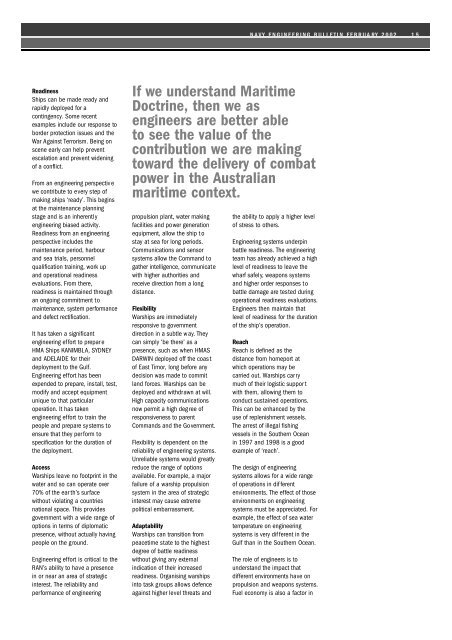ENGINEERING - Royal Australian Navy
ENGINEERING - Royal Australian Navy
ENGINEERING - Royal Australian Navy
You also want an ePaper? Increase the reach of your titles
YUMPU automatically turns print PDFs into web optimized ePapers that Google loves.
N A VY E N G I N E E R I N G B U L L E TI N FE B R U A RY 2 0 02<br />
1 5<br />
Re a d i n e s s<br />
Ships can be made ready and<br />
rapidly deployed for a<br />
contingency. Some recent<br />
examples include our response to<br />
border protection issues and the<br />
War Against Terrorism. Being on<br />
scene early can help prevent<br />
escalation and prevent widening<br />
of a conflict.<br />
From an engineering perspective<br />
we contribute to every step of<br />
making ships ‘ready’. This begins<br />
at the maintenance planning<br />
stage and is an inherently<br />
engineering biased activity.<br />
Readiness from an engineering<br />
perspective includes the<br />
maintenance period, harbour<br />
and sea trials, personnel<br />
qualification training, work up<br />
and operational readiness<br />
evaluations. From there,<br />
readiness is maintained through<br />
an ongoing commitment to<br />
m a i n tenance, system perfo rm a n c e<br />
and defect re c t i fi c a t i o n .<br />
It has taken a significant<br />
engineering effort to prepar e<br />
HMA Ships KANIMBLA, SYDNEY<br />
and ADELAIDE for their<br />
deployment to the Gulf.<br />
Engineering effort has been<br />
expended to prepare, install, test,<br />
modify and accept equipment<br />
unique to that particular<br />
operation. It has taken<br />
engineering effort to train the<br />
people and prepare systems to<br />
ensure that they per form to<br />
specification for the duration of<br />
the deployment.<br />
Ac c e s s<br />
Warships leave no footprint in the<br />
water and so can operate over<br />
70% of the ear th’s surface<br />
without violating a countries<br />
national space. This provides<br />
government with a wide range of<br />
options in terms of diplomatic<br />
presence, without actually having<br />
people on the ground.<br />
Engineering effort is critical to the<br />
RAN’s ability to have a presence<br />
in or near an area of strategic<br />
interest. The reliability and<br />
performance of engineering<br />
If we understand Maritime<br />
Doctrine, then we as<br />
engineers are better able<br />
to see the value of the<br />
contribution we are making<br />
toward the delivery of combat<br />
power in the <strong>Australian</strong><br />
maritime context.<br />
propulsion plant, water making<br />
facilities and power generation<br />
equipment, allow the ship t o<br />
stay at sea for long periods.<br />
Communications and sensor<br />
systems allow the Command to<br />
gather intelligence, communicate<br />
with higher authorities and<br />
receive direction from a long<br />
distance.<br />
F l e x i b i l i t y<br />
Warships are immediately<br />
responsive to government<br />
direction in a subtle way. They<br />
can simply ‘be there’ as a<br />
presence, such as when HMAS<br />
DARWIN deployed off the coas t<br />
of East Timor, long before any<br />
decision was made to commit<br />
land forces. Warships can be<br />
deployed and withdrawn at will.<br />
High capacity communications<br />
now permit a high deg ree of<br />
responsiveness to parent<br />
Commands and the Government.<br />
Flexibility is dependent on the<br />
reliability of engineering systems.<br />
Unreliable systems would greatly<br />
reduce the range of options<br />
available. For example, a major<br />
failure of a warship propulsion<br />
system in the area of strategic<br />
interest may cause extreme<br />
political embarrassment.<br />
Ad a p ta b i l i t y<br />
Warships can transition from<br />
peacetime state to the highest<br />
degree of battle readiness<br />
without giving any external<br />
indication of their increased<br />
readiness. Organising warships<br />
into task groups allows defence<br />
against higher level threats and<br />
the ability to apply a higher level<br />
of stress to others.<br />
Engineering systems underpin<br />
battle readiness. The engineering<br />
team has already achieved a high<br />
level of readiness to leave the<br />
wharf safely, weapons systems<br />
and higher order responses to<br />
battle damage are tested during<br />
o p e rational readiness eva l u a t i o n s .<br />
Engineers then maintain that<br />
level of readiness for the duration<br />
of the ship’s operation.<br />
Re a ch<br />
Reach is defined as the<br />
distance from homeport at<br />
which operations may be<br />
carried out. Warships carry<br />
much of their logistic suppor t<br />
with them, allowing them to<br />
conduct sustained operations.<br />
This can be enhanced by the<br />
use of replenishment vessels.<br />
The arrest of illegal fishing<br />
vessels in the Southern Ocean<br />
in 1997 and 1998 is a good<br />
example of ‘reach’.<br />
The design of engineering<br />
systems allows for a wide range<br />
of operations in dif ferent<br />
environments. The effect of those<br />
environments on engineering<br />
systems must be appreciated. For<br />
example, the effect of sea water<br />
temperature on engineering<br />
systems is very dif ferent in the<br />
Gulf than in the Southern Ocean.<br />
The role of engineers is to<br />
understand the impact that<br />
different environments have on<br />
propulsion and weapons systems.<br />
Fuel economy is also a factor in
















